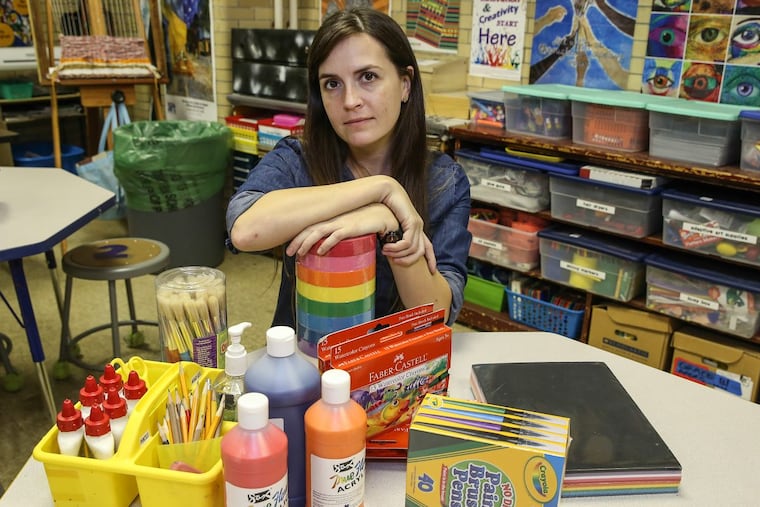Teachers spend hundreds from their pockets on school supplies: 'Honestly, there's no choice'
Greg Kauriga, a music teacher at Loesche Elementary in Philadelphia, spends at least $2,000 a year on classroom supplies. "You want to do your job right, so you're going to keep on getting stuff. And we know we're never going to get that money back."

The art room at Nebinger Elementary in South Philadelphia is a wonderland, stuffed with colorful student work and an abundance of supplies — from paper and pastels to tools for printmaking and sculpting.
Every tube of paint, glue gun, and sketchbook is there because teacher Leslie Grace made it happen. In addition to the robust fundraising she does in her free time, Grace spends at least $3,000 of her own money on her classroom every year. She built her art room from a budget of zero.
"I want my students to have as many exposures to art as possible, and if I'm spending my own money doing it, that's just the burden I bear," said Grace.
Teachers have long dipped into their own pockets to fund their classrooms. Across the country, the average educator spends $350 of her or his own money annually on supplies and other items — from apps to enhance their students' experiences to food and clothes to meet their basic needs, according to Scholastic, the publishing, education, and media company. Teachers in high-needs districts like Philadelphia tend to spend 40 percent more than their peers.
Educators now can claim a $250 school-supply deduction on their taxes; proposed federal legislation would have scrapped that, but the sweeping new tax code preserved it.
"For taxes, I only claim $200, but I spend more than that each year, for sure — on different things, supplies, books, projects," said Danielle Arnold Schwartz, a veteran teacher in Lower Merion – Pennsylvania's wealthiest district – who currently works with gifted students in two elementary schools. Schwartz said there are times when her class needs something like glue sticks and there's less red tape if she buys it herself.
"We'll lay out the money because we want the kids to stay on schedule," Schwartz said, adding quickly that the situation is nothing like Philadelphia's cash-strapped schools, where she said teachers are buying essentials like toilet paper.
In the Chester Upland school system, Chester High School special education teacher Nikkita George said she buys paper, pencils, notebooks, and even gift bags as rewards for students who do well.
"Last year, we went bowling once a month," she said, "and I might have had five students that needed $10 to eat, so I would put $30 to $40 up, so they could eat."
Meg McGettigan, a veteran kindergarten teacher at Meade Elementary in North Philadelphia, has always dipped into her own pocket for school supplies. The need has increased steadily over her 30 years, she said.
Parents do send in some supplies — tissues, hand sanitizer, table wipes — but not nearly enough to last the year, and McGettigan buys the rest herself, or raises funds. She estimates she spends about $700 annually, on top of the hundreds raised through Donors Choose.
Some of her students need clothes, and McGettigan provides those when she has to — socks, gloves, uniform shirts.
"Any time there's a clearance sale at Kmart, I hit it hard," she said.
The spending gives McGettigan and other teachers pause.
"You often make the argument in your head, 'Do I really need this?' And it's always, 'Yeah, I do. The kids need it,'" said McGettigan.
Greg Kauriga, a music teacher at Loesche Elementary in the Northeast, spends at least $2,000 a year. His wife, who also teaches in the city, spends about the same amount.
"Honestly, there's no choice," said Kauriga. "You want to do your job right, so you're going to keep on getting stuff. And we know we're never going to get that money back."
Kauriga spends on paper, music downloads, books, and apps to use with his students.
"I don't even keep track of all of it," he said. "If you need a copy of a book, you go to Amazon and you get it."
Maddie Luebbert, a first-year teacher at Kensington Health Sciences Academy in Philadelphia, has spent more than $100 of her own money, supplemented by help from friends and family, including her mother, who also teaches in the city. She's purchased erasers, folders, dry erase board erasers, and tape, but most of her spending has been on decorations for her classroom — posters of people Luebbert thought would be good role models, like Bayard Rustin, John Lewis, and Fannie Lou Hamer.
"To set the stage, you have to have a welcoming classroom," said Luebbert, "but it doesn't come cheap."
Luebbert feels lucky to have a network of people who can support her classroom, but knows that not everyone has that.
"I just worry about how much burden goes onto teachers," Luebbert said. "If they aren't able to produce that kind of output, I worry about how that reflects on them. If you aren't going above and beyond, you're not doing your job, and we're not compensated for all of it."